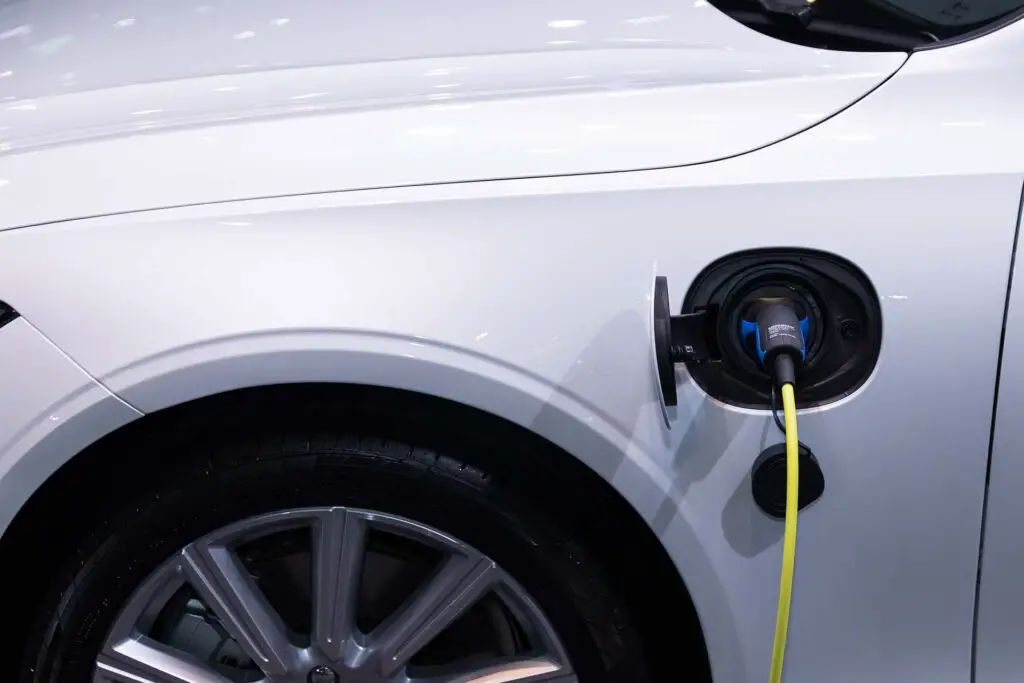When it comes to traditional modes of transportation, the power source is pretty obvious. However, do electric cars use gas as well? It’s a common question with a surprisingly simple answer, so let’s dive into the inner workings of these impressive four-wheelers and demystify this myth once and for all.
So, do all electric cars use gas? No, electric vehicles (EVs) do not need gasoline to operate, unlike conventional gasoline-powered vehicles. That’s because EVs rely on electricity as their primary source of energy – they are equipped with rechargeable batteries that store electricity, which powers the motor to propel the vehicle.
Do Electric Cars Use Gas – What’s the Right Answer?
It’s clear that owning a gasoline-powered car entails hitting up the gas station quite frequently during your driving career. However, you might be wondering – do electric cars also use gas? The answer is straight and simple – no, they don’t need gasoline to work and cruise down the famous US routes.

Understand the Fuel Source – Gasoline vs. Electricity
A traditional internal combustion engine (ICE) operates by burning fuel, typically gasoline, to generate power. The process begins when a mixture of fuel and air is drawn into the engine’s cylinders through intake valves. Within the cylinders, the piston moves upward, compressing the fuel-air mixture, and a spark plug ignites it, causing a controlled explosion.
The resulting explosion forces the piston downward, turning the engine’s crankshaft. This rotational motion is then transmitted through various components, such as the transmission and drivetrain, ultimately propelling the vehicle forward. The byproducts of combustion, including carbon dioxide, water vapor, and other emissions, are expelled through the exhaust system.
EVs Use Electricity as Their Primary Source of Power
So, the traditional ICE system relies on continuous supply from the fuel tank and the process of intake, compression, combustion, and exhaust in a repeated cycle. On the other hand, EVs are equipped with a large battery pack that stores electrical energy – once the driver activates their vehicle, the battery sends the needed electricity to the motor.
The electric motor converts the electrical energy into mechanical energy, which is used to turn the wheels and propel the vehicle forward. This means that, unlike internal combustion engines, EVs do not require fuel combustion and have no tailpipe emissions.

Are Electric Cars Really Gasoline-Free Transportation Options?
Sure, it might sound too good to be true, especially if you’re looking for ways to cut down car expenses. Just imagine telling the person who designed the first car ever that less than 200 years later, modern vehicles won’t even need fuel to get you where you need to go.
However, it’s entirely true, and while there are plug-in hybrid (PHEV) vehicles that do require fuel but can also operate with the help of a battery, EVs operate solely on electricity and do not require any fuel whatsoever. No more stress about putting the wrong gas in your car, experiencing driving anxiety, or suffering a considerable expense if any of the ICE components are not working properly.

How Do You Charge Electric Cars?
The charging infrastructure for EVs plays a crucial role in supporting their widespread adoption and increasing popularity. It’s a network of charging stations that provide electricity to recharge the batteries on these vehicles, and it’s continually expanding to accommodate the growing number of EVs on the road.
What Charging Options Are There?
Governments, private companies, and organizations are investing in the installation of charging stations, aiming to enhance accessibility and convenience for EV owners. Moreover, digital platforms and smartphone apps provide real-time information about the location and availability of charging stations, assisting drivers in planning their charging stops efficiently.
As of now, here are the charging options you have:
Home Charging
Home charging refers to the ability to charge an EV at one’s residence. It involves installing a charging unit, commonly referred to as electric vehicle supply equipment (EVSE), at a dedicated parking spot or garage.
Home charging typically utilizes a Level 2 charger, which provides a faster charging rate compared to a standard household outlet. This is obviously the most convenient option for EV owners, as they can plug their four-wheelers into EVSE overnight or whenever needed.
Public Charging Stations
Public charging stations are located in various public areas and provide an option for EV owners to charge their vehicles while away from home. These charging stations can be found in places like shopping malls, parking lots, restaurants, and city centers.
Public charging stations offer a range of charging speeds, typically Level 2 and Level 3, allowing drivers to replenish their battery power during extended trips or when they don’t have access to home charging.
Fast Charging
Fast charging, often referred to as DC fast charging, is a high-powered charging option that enables rapid charging for EVs. It uses direct current, hence the name, and charges the vehicle’s battery at a significantly faster rate compared to Level 2 chargers.
Fast charging stations are commonly available along highways, major travel routes, and select public locations. They can charge an EV’s battery to approximately 80% capacity in as little as 30 minutes, depending on the vehicle’s compatibility and the charger’s power output.
You Should Consider Range and Battery Before the Ride
EVs have made significant progress in terms of range, meaning the distance they can travel on a single charge, but they still face certain limitations. Contrary to popular belief, these limitations are not due to gas usage but due to various factors such as driving conditions, weather, speed, and vehicle load.
One crucial factor is the battery capacity, which determines the amount of energy that can be stored and used for driving. However, this capacity can decrease over time as the battery ages, which results in EV’s limited range. Capacity, extreme temperatures, frequent acceleration, air conditioning, and so on – being mindful of these factors can help maximize the range of your EV and optimize the overall driving experience.

What Is the Environmental Impact of Electrical Vehicles?
The evolution of cars is steadily developing eco-friendly modes of transportation, and EVs are a big part of that battle. To fully understand just how much better they are for the environment, here’s an overview of the main differences between traditional gasoline-powered vehicles and electric ones:
| Environmental Aspect | Gasoline Vehicles | Electric Vehicles |
| Tailpipe Emissions | Produce emissions, including CO2 and pollutants such as nitrogen oxides (NOx) and particulate matter (PM) | Produce zero tailpipe emissions |
| Greenhouse Gas Emissions | Contribute to climate change due to CO2 emissions from burning fossil fuels | Depending on the electricity source, emissions can be lower if powered by renewable energy |
| Air Quality | Emit pollutants that contribute to smog and poor air quality in urban areas | Help improve local air quality as they do not emit pollutants directly |
| Noise Pollution | Produce engine noise and contribute to noise pollution in urban areas | Operate quietly, reducing noise pollution |
| Energy Efficiency | Have lower energy efficiency due to energy losses in the combustion process | Have higher energy efficiency, converting more energy into propulsion |
| Resource Consumption | Rely on finite fossil fuel resources, leading to resource depletion | Rely on electricity, which can be generated from renewable sources, reducing resource consumption |
| Manufacturing Impacts | Involve manufacturing processes that can generate greenhouse gas emissions and resource depletion | Involve manufacturing processes, but impacts can be reduced with sustainable practices |
| Waste Generation | Generate waste from motor oil, filters, and other vehicle components | Generate waste from battery disposal, but battery recycling programs are improving |
How Does Having an Electric Car Benefit Your Budget
Sure, the EV you’re interested in might come with a high price tag, but the truth is that these four-wheelers also come with great saving opportunities in the department of car expenses. Here are the costs associated with gasoline-powered vehicles that will simply be a thing of the past if you opt for an EV:
- Fuel costs – the price of gasoline can vary and is subject to fluctuations in global oil prices, whereas charging an EV can be cheaper depending on electricity rates and charging infrastructure,
- Oil changes and fluid maintenance – gasoline cars require periodic oil changes and other fluid maintenance tasks, which might involve purchasing new oil and paying for labor,
- Emissions testing and compliance – gasoline vehicles are subject to emissions testing requirements in many regions, and ensuring that the vehicle meets the required emission levels can be an additional expense,
- Engine maintenance – gasoline engines have complex mechanical components that require regular maintenance and repairs, including spark plug replacements, belt changes, and fuel system maintenance,
- Fuel tax and road use charges – gasoline vehicles are subject to fuel taxes imposed by governments to fund road infrastructure and transportation initiatives.
What Are Potential Cost Savings Associated With Electric Vehicles?
As you can see from the list above, EVs offer potential cost savings in several areas. When it comes to keeping the four-wheeler running, EVs typically have lower operating costs compared to gasoline-powered cars since electricity is generally cheaper than gasoline.
Moreover, EVs require less maintenance due to their simpler mechanical components, and this can result in lower maintenance and servicing expenses over time. Add government incentives to the mix, and the prospect of owning an EV seems to be more and more economically attractive.

What Are Some of the Most Common Misconceptions and Myths About Electric Four-Wheelers?
There’s a special kind of driving anxiety that’s connected to EVs, and it’s known as range anxiety. It relies on the false belief that EVs have extremely limited ranges, even though newer models offer improved ranges suitable for daily commuting and longer trips.
Another misconception is the lack of charging infrastructure, when in fact, public charging stations, workplace charging, and home charging options are increasingly available. Moreover, the availability of Level 2 and DC fast charging stations have significantly reduced charging times for EVs.

Driving Electric Car Comes With Many Benefits
In conclusion, it’s become clear that electric vehicles do not use gas as a source of energy. Moreover, due to their innovative design and mechanism, they come with various benefits in comparison to gasoline-powered vehicles. Not only have the automakers developed reliable, efficient four-wheelers, but car owners now have the incentive to think green when it comes to transportation needs. So why not consider making the switch today?








